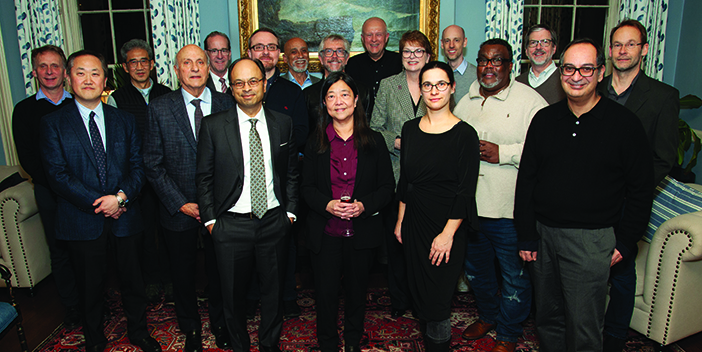Brown hosts the first international working group meeting to sequence all of humanity’s RNA.
In January, RNA experts from around the world gathered at Brown to roll up their sleeves and get to work on a venture that many of them say will likely be bigger, more expensive, and more daunting than the Human Genome Project.
But the outcome of this effort, known as the Human RNome Project, will also be even more consequential for human health, offering clues to develop vaccines, unlock mysteries behind rare diseases, and discover treatments for some of humanity’s most intractable illnesses, like Alzheimer’s, diabetes, and many cancers.
“This is the first international effort on RNome,” said Vivian Cheung, MD, the lead organizer of the three-day working group meeting, the first of many to come. “The Genome Project had several of these planning meetings, and they have become famous by the location where they were done. There was a Bermuda convention, a Fort Lauderdale meeting. … So a little tongue-in-cheek, we’re hoping that this will become the ‘Rhode Island meeting.’”
The Human RNome Project aims to identify and quantify all RNAs and map their modifications, in both normal and diseased human cells and tissues. The mission is complicated by a lack of technology that can accurately read RNA molecules and, specifically, those modifications: tiny tweaks to the nucleotides that are critical to an RNA’s function. The COVID-19 vaccine, for example, was only possible due to a modification to the messenger RNA molecule. There are at least 170 known modifications, said workshop co-organizer Peter Dedon, MD, PhD.
“Everything’s got a modification. And that means they can get screwed up in many different ways for disease,” he said.
But we don’t know what many of those modifications do—or even the purpose of many of our RNAs. The Human Genome Project found that we have 65,000 total genes, Dedon said, only 20,000 of which code for mRNA, which makes proteins. The rest code for RNAs of varying and often unknown functions.
“This is a mess. It’s a wonderful mess,” Dedon said in his welcome remarks to his colleagues. “What are all these things doing?”
Figuring that out, many attendees said, will truly transform biomedical research and human health.
“This work, the Human RNome Project, has the potential to improve our understanding of disease and to advance therapeutics to better serve patients for generations to come,” said US Sen. Jack Reed, D-RI, who spoke to the scientists via Zoom. “It truly is a transformative moment in medical research and medical investigation. And we have to seize that moment.”
After the workshop, Reed, a senior member of the Senate Appropriations Committee, added in a statement, “Brown University is well-positioned to serve as the home base for this important work and I am committed to helping bring federal dollars to support the effort.”
Dean Mukesh K. Jain, MD, offered to host the workshop in part to highlight Brown’s growing commitment to RNA research. The campus is now home to the brand-new Brown RNA Center and numerous experts in the field, led by Juan Alfonzo, PhD, professor of molecular biology, cell biology, and biochemistry.
“I am jealous as hell of everything that’s happening down here and the infrastructure that’s being built and what Juan Alfonzo is doing now to create a big program across the campus,” said Dedon, a biomedical engineer at MIT.
Shortly after becoming dean, in March 2022, Jain announced that RNA biology would be a research priority for the Division. But even before his arrival on campus, Jain urged The Warren Alpert Foundation—which had awarded the 2022 Warren Alpert Prize to the scientists behind the COVID vaccine, two of whom later went on to win the Nobel Prize—to support the RNome project, telling them it was a “once-in-a-lifetime opportunity” to get in on the ground floor of something truly transformative.
“It piqued our interest, because of our mission as a foundation, which overlaps 99.9 percent with the RNome project,” David M. Hirsch, the chairman of The Warren Alpert Foundation, said.
Quoting that mission—“the promotion of medical science through research and education, particularly in areas which offer the promise of achieving significant medical breakthroughs in the prevention, treatment, and cure of human conditions, and diseases”—Hirsch added, “The Human RNome Project is one of the most ambitious scientific endeavors of our time.”
In addition to January’s workshop, the foundation has funded RNA research and a National Academies of Science, Engineering, and Medicine committee report that includes Alfonzo and is developing a roadmap to sequence the RNome.
Cheung, a pediatric neurologist and RNA biologist from the University of Michigan, said the RNome working groups will carry out the “marching orders” of the NASEM white paper. The workshop participants were divided into four smaller groups, each tasked with coming up with recommendations to tackle the biggest issues related to the RNome, from technologies needed to workforce development.
After the workshop, she said each group emerged with a “concrete” to-do list. “I was really surprised how enthusiastic people were and how willing they are to start working,” she said, adding that the groups will meet at least monthly and that more people will get involved as time goes on.
Frederick L. Tyson, PhD, was one attendee who said he is “willing to do the work.” He is a program director at the National Institute of Environmental Health Sciences, where for several years he’s been working to support projects that investigate the regulatory roles of RNAs in environmental exposures. When he learned from Cheung about the enormous potential for human health that a fully sequenced RNome would bring, he wanted to be a part of the effort.
“If we’re able to really develop new technologies and resources that are being called for by the RNA community, if we’re able to develop these effectively and successfully, it’ll really catalyze a kind of revolutionary advance, both in the way we’re able to conduct basic research, but also in clinical applications that are going to use RNA-based therapeutics,” Tyson said. “I hope that almost everyone on the globe that went and got vaccinated [against COVID]can appreciate not only the importance, but the impact that this can have.”
While the NIH may be able to offer some support for the Human RNome Project, Tyson said, fully funding the enterprise will require congressional approval, not to mention investments from governments around the world. Mark Helm, PhD, the workshop’s third co-organizer, came to Providence from Mainz, Germany—the hometown of BioNTech, which partnered with Pfizer to create an mRNA COVID vaccine.
“Europe looks to the US to take the initiative here,” Helm said. “We would, as Europeans, greatly profit from this if we could do this together. It would be a lot easier for us to talk to our governments and the funding agencies to fork up some money.”
The ultimate goal of the working group is a publication laying out how the RNome Project will be implemented. Like the Human Genome Project, it will require the participation of government agencies, academic institutions, and private entities from around the world, and will likely take decades to complete. The “Rhode Island meeting” was just the first step of what all the participants hope will be a victorious ultramarathon.
“It’s not going to be easy,” Tyson said, “but you have to start somewhere.”




